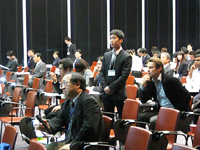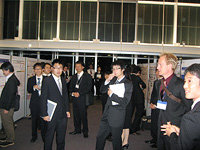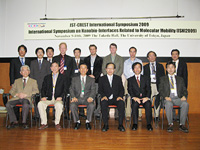As part of the CREST research theme entitled "Design of Multi-Dimentional Biological Interfaces through Manupulating Molecular Mobility" (principle investigator: Nobuhiko Yui, professor of Japan Advanced Institute of Science and Technology: CREST research area "Development of the foundation for nano-interface technology"), the "International Symposium on Nanobio-Interfaces Related to Molecular Mobility" was held at the Takeda Hall, The University of Tokyo from Nov. 9 through 10, 2009 (number of registered participants: 118 people).
Following the initial briefing on JST and CREST by Director Osamu Ichimaru of JST, a total of 13 lectures consisting of lectures by invited speakers (4 themes from abroad, 5 themes from Japan) and 4 presentations on researches by the CREST team were held.



Professor Phillip B. Messersmith of Northwestern University in the U.S. explained about the basics of material design that imitated marine adhesive protein and its application as biomaterials. Assistant professor Mattias P.Lutolf of Swiss Federal Institute of Technology explained about the wide range of applications of hydrogel design as the environment for stem cell differentiation. Assistant professor Mattias Berglin of University of Gothenburg in Sweden presented a number of research case examples regarding the relationship between surface molecular mobility and biomaterial functions. Professor Dennis E. Discher of University of Pennsylvania in the U.S. (due to a last minute cancellation of his participation, substituted by Dr. Amnon Buxboim) explained about the relationship between the coefficient of elasticity of biomaterial surfaces and stem cell differentiation induction.
In particular, at this international symposium, we invited researchers from abroad from the perspective of molecular mobility control and bio-interface creation, and it was meaningful that we were able to build a new network of personal contacts. As a Japanese guest speaker, Professor Atsushi Takahara of Kyushu University presented the soft surface analysis within the ERATO project that he is heading. Professor Keiji Naruse of Okayama University presented the cell function change by dynamic stimulus. Professor Satoru Kidoaki of Kyushu University presented the biomaterial design based on the perspective of mechanobiology. Professor Masaru Tanaka of Yamagata University presented the cell function induction in honeycomb pattern structure surface. Assistant professor Sasaki of Tokyo Medical and Dental University presented the new sensing by complex formation of functional lipid and genes. From the CREST team, Yui, Ishihara, Kishida and Yamaoka reported the progress of each groupís research. After the lectures, Seiji Shinkai, the research supervisor of CREST, summed up the symposium and gave a statement on the positioning of CREST and his expectations on how the CREST team should proceed in the future.
At this international symposium, presentations were organized with a focus on the relationship between bio-interfaces and molecular mobility, which this CREST team is promoting. In particular, we aimed to collect the latest information and discuss the direction that this CREST team should strengthen when engaging in future researches, and we were able to obtain valuable information on cell function control that is expected by surface analysis method and surface molecular mobility control. In the evening of the first day and in the morning of the second day, 35 poster presentations were held and short two-minute oral presentations were also given by each poster presenter. Four outstanding presentations were selected out of 35 poster presentations by asking the 9 guest lecturers to rate them, and the winners were given the Best Poster Awards at the closing ceremony.
JST, an integrated organization of science and technology in Japan, establishes an infrastructure for the entire process from the creation of knowledge to the return to the society. For more information, visit http://www.jst.go.jp/EN/